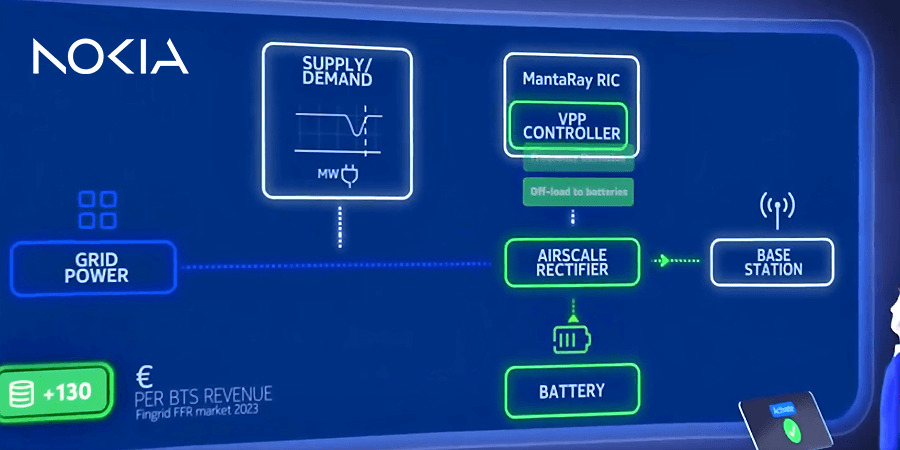Nokia has launched the Nokia Virtual Power Plant (VPP) Controller Software— a unique near-real-time software-based end-to-end platform that helps mobile operators monetize the existing backup batteries at base station sites. Nokia claims to have completed several trials and aims to make the solution available later this year. The solution is the latest example of Nokia’s energy efficiency solution portfolio.
Stabilizing the Electricity Grid
Nokia’s VPP Controller Software contributes to the stability of the electricity grid and creates a new purpose and function for the base station backup batteries which are usually idle as power cuts can be rare. Most countries have a transmission system operator that manages the electricity grid and oversees the power reserve markets. Power reserve markets operate via an auction system that enables third parties to bid to provide power. Through bidding and winning, an operator can use their backup batteries to run their base stations while maintaining normal operations and providing energy to the market instead of using the grid energy. This turns their battery backup power systems into an investment with a steady financial return. Additionally, the system supports renewable solar energy production. Incorporating reserve power from the electricity grid helps prevent power outages and diminishes the grid's carbon dioxide emissions.
Also Read: Bridging the Digital Divide: Nokia's Commitment to Neutral Hosting in the Middle East and Africa
Nokia’s VPP Controller Software ensures that it is safe to use batteries in the power reserve marketplace and estimates how much extra backup battery capacity is available based on the power-consumption profiles for each power station. It uses machine learning (ML) algorithms to create smart offerings based on the actual and the predicted power consumption and the related extra backup power capacity. Nokia's solution incorporates the auction bidding process within the power reserve market, streamlining entry for mobile operators and ensuring a seamless and straightforward experience. This includes the Fast Frequency Reserve market, which requires a sub-second reaction time to offload from the grid and monetize the batteries. This low latency is achieved by using near-real-time processing servers and Nokia’s power system.
Zero-Traffic Zero-Energy Radio Solution
Nokia reaffirmed its dedication to extreme energy efficiency through various product enhancements. These include the introduction of the 'extreme deep sleep cell-switch-off' mode, powered by software in Nokia's AirScale Habrok Massive MIMO radio units. This innovative mode reduces energy consumption by up to 97% compared to when a cell is active (without traffic). Additionally, Nokia introduced the 'zero-traffic, zero-energy' solution, which deactivates all radio resources during periods with zero-traffic, further optimizing energy usage.
Tommi Uitto, President of Mobile Networks at Nokia, said, “Nokia’s Virtual Power Plant is an incredible innovation that will help our customers monetize the energy stored in their backup batteries while also reducing carbon emissions. We are committed to continuously maximizing the energy efficiency of our technology portfolio. Our energy-efficient hardware, combined with software features such as Extreme Deep Sleep, is the key to reducing the energy consumption, carbon emissions, and related costs of mobile networks.”
Nokia AirScale Portfolio Enhancements
At Mobile World Congress 2024, Nokia will showcase its radio leadership with enhancements to its comprehensive AirScale product portfolio including its range of energy-efficient solutions.
Also Read: Nokia’s 5 New Digital Enablers for Industrial Transformation











